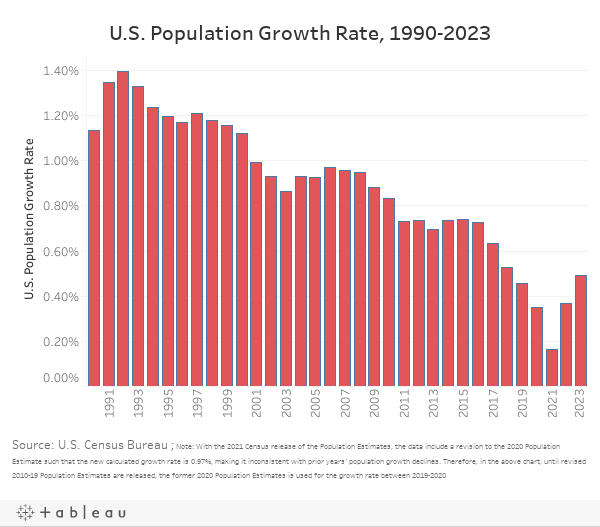U.S. Population Growth Returns to Pre-Pandemic Levels
Jesse Wade2024-01-22T08:19:39-06:00According to the U.S. Census Bureau’s latest estimates, the U.S. resident population grew by 1,643,484 to a total population of 334,914,895. The population growth rate reached its highest level since the pandemic at 0.49%. This is just above the 2019 growth rate (0.46%), while slightly below the 2018 growth rate (0.53%). The Census Bureau reports that the primary source for the increase in population growth was net international migration, as migration levels returned to pre-pandemic levels. Total net international migration has been approximately one million for the past two years, as net international migration levels were at 999,267 in 2022 and at 1,138,989 in 2023. These consecutive high levels of increase suggest international migration trends are returning to normal. The other driver of the U.S. population growth rate was positive natural births (births minus deaths), which increased the total population by 504,495. The level of positive natural births in 2023 was 126% higher than 2022 largely due to the 8.9% drop in the number of deaths in 2023. There was also a decline in the number of births of 0.7%. Regionally, the Northeast region was the only region to lose population, declining 0.08%. The South region led in population growth at 1.11% while the Midwest population grew 0.18% and the West grew 0.17%. At the State level, 42 States and D.C. had a population increase over the year, the highest number since the start of the pandemic. South Carolina led the way with population growth at 1.71%. Florida was a close second, growing 1.64%, followed by Texas at 1.58%. Numerically, four States’ populations have increased by over 100,000. Texas experienced a 473,453 increase in population, Florida increased by 365,205, North Carolina increased by 139,526, and lastly Georgia increased by 111,077 persons. For the third straight year, New York’s population declined at the fastest rate of all 50 states at 0.52%. This was followed by Louisiana with a decline of 0.31%, and a decline in Hawaii of 0.30%. New York also had the highest numeric decline of 101,984 followed by California with a decline of 75,423. Eight states lost population according to Census estimates. Despite three consecutive years of population decline, California remained the most populous state by a healthy margin. California’s population was at 39,040,616 while the next most populous state was Texas at 30,503,301. The next three most populous states were Florida (22,610,726), New York (19,571,216), and Pennsylvania (12,961,683) to round out the top five States by total population. The linked table here shows the population in thousands for each state in 2021, 2022, and 2023 and the percentage change for each respective year. ‹ Existing Home Sales End 2023 at the Lowest Level Since 1995Tags: census bureau, demographics, Florida, population, Texas

